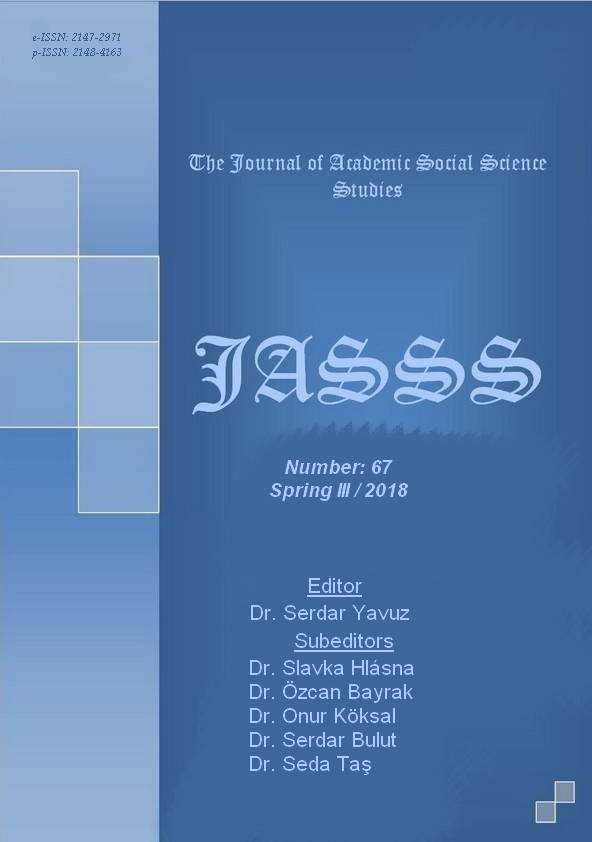Author :
Abstract
Engelli bireylere gerek toplumun ve gerekse tek tek bireylerin bakış açısı birbirinden farklıdır. Genel olarak bakış açısı ise, onlara acımak, yardım etmek ve onları yok sayıp, ikinci plana itmektir. Bu problemin temelinde ise engelli kişilere yönelik olumsuz tutumlar yatmaktadır. Bu problemin temelinde ise engelli kişilere yönelik olumsuz tutumlar yatmaktadır. Engelli bireylere yönelik tutumlar ile; görme, işitme, zihinsel ve ortopedik engeli bulunan kişilerle ilgili düşüncelerin, inançların ve duyguların bütünü kast edilmektedir. Bu bağlamda engelliler hakkında oluşan olumsuz tutumları belirlemek, bunları gidermeye çalışmak ve engellilerin toplumla bütünleşmesini sağlamak için toplumsal duyarlılığın ve farkındalığın artırılması gerekmektedir. Bu amaçla üniversite personelinin engelli bireylere yönelik tutumlarını belirlemeyi amaçlayan bu çalışmaya Kırıkkale Üniversitesi Fen-Edebiyat Fakültesi, Hukuk Fakültesi ve Sağlık Bilimleri Fakültesi’nde görev yapan 150 akademik ve idari personel katılmıştır. Çalışmada, veri toplama yöntemi olarak anket tekniği kullanılmıştır. Anket bireysel özelliklerin yer aldığı birinci bölüm ile Kaner (2008) tarafından geliştirilen “Özürlülere Yönelik Tutum Ölçeği”nin yer aldığı ikinci bölümden oluşmaktadır. Söz konusu ölçme aracı Başbakanlık Özürlüler İdaresi Başkanlığı’nca yapılan “Toplum Özürlülüğü Nasıl Algılıyor” isimli çalışma kapsamında geliştirilmiştir. Araştırmada katılımcıların demografik özellikleri frekans ve yüzde dağılımları ile sunulmuş olup her bir maddeye ilişkin tutumları ise yüzde dağılımı, aritmetik ortalama ve standart sapma değerleri ile betimlenmiştir. Bununla birlikte katılımcıların engellilere yönelik genel tutumlarının demografik özelliklere göre karşılaştırılmasında t-testi ve varyans analizi uygulanmıştır. Ayrıca engelli tutum ölçeği ve alt ölçeklerine yönelik güvenirlik analizi için Cronbach’s Alpha katsayıları hesaplanmıştır. Araştırmaya alınanlar arasında; 30 yaş ve altındakiler, kadınlar, doktora eğitimi alanlar, 3501-4500 TL aylık gelire sahipler, akademik personeller ve ünvanı araştırma görevlisi ve öğretim görevlisi olanlar önde gelmektedir. Alt ölçeklere ilişkin ortalamalar incelendiğinde en olumlu tutum içerisinde olunan alt boyutun “eğitim ortamı”, en olumsuz tutum içerisinde olunan alt boyutun ise “aile yaşamı” olduğu tespit edilmiştir. Araştırma sonucunda; üniversite personelinin engelli bireylere yönelik tutumlarının cinsiyete göre anlamlı bir farklılık göstermediği (p>0,05) belirlenirken; yaşa, eğitim düzeyine, aylık gelire, görev durumuna, unvana göre anlamlı bir farklılık gösterdiği (p
Keywords
Abstract
The point of view of disabled people, society and individual individuals is different. In general, the point of view is to pity them, to help them, to ignore them and push them to the second plan. On the basis of this problem lies the negative attitudes towards disabled people. On the basis of this problem lies the negative attitudes towards disabled people. Attitudes towards disabled people; beliefs and feelings about people with visual, hearing, mental and orthopedic disabilities. In this context, it is necessary to increase social awareness and awareness in order to determine the negative attitudes towards the disabled, to try to avoid them and to integrate the disabled into society. For this purpose 150 academic and administrative personnel working at Kırıkkale University Faculty of Science and Letters, Faculty of Law and Faculty of Health Sciences participated in this study aiming to determine the attitudes of university personnel towards disabled people. In the study, survey technique was used as data collection method. The questionnaire consists of the first part in which individual characteristics are included and the second part in which the "Attitudes Towards the Disability Scale" developed by Kaner (2008). This measurement tool was developed within the scope of the named work "How the society perceives disability" made by Prime Ministry Administration for Disabled People. Demographic characteristics of the participants were presented by frequency and percentage distributions, and attitudes of each item were described by percentage distribution, arithmetic mean and standard deviation. However, t-test and variance analysis were used to compare participants' general attitudes towards disabilities according to their demographic characteristics. Cronbach's Alpha coefficients were also calculated for reliability analysis of disability attitude scale and subscales. Among those who were involved in the research; Those who are 30 years old or younger, women, doctorate students, 3501-4500 TL monthly income holders, academic staffs and research assistants and lecturer. When the averages of the sub-scales are examined, it is determined that the sub-dimension of the most positive attitude is the "educational environment" and the sub-dimension of the most negative attitude is the "family life". As a result of the research; while the attitudes of the university staff towards disabled people did not show any significant difference according to sex (p> 0,05); age, educational level, monthly income, job status and title (p





